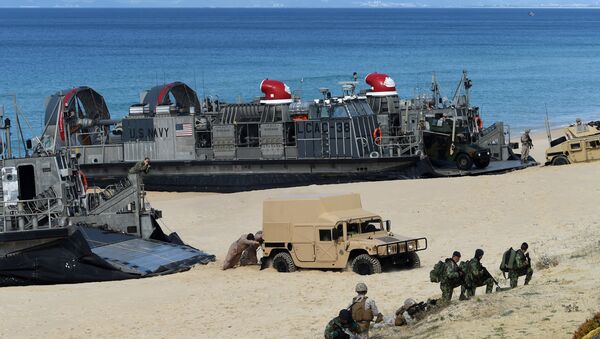The war-games, which are scheduled to last until November 6, are truly massive. Approximately 36,000 troops, over 140 aircraft and 60 ships from all NATO member states and seven partner nations, including Australia, Austria, Bosnia and Herzegovina, Finland, Macedonia, Sweden and Ukraine, are taking part in the month-long drills held primarily in Italy, Portugal and Spain.
36,000 #soldiers need food, water and goods — #TJ15 not only military training but also logistics @NATO_JFCBS pic.twitter.com/uV6wZ6gRhB
— Italy at NATO (@ITALY_NATO) 23 октября 2015
The exercise is allegedly meant to prepare the bloc and its allies to respond quickly and efficiently to any crisis situation in the ever-changing security environment. Although no specific information has been provided to illustrate the multi-dimensional threats NATO faces, the bloc's officials made mention of Russia and Islamic extremism in related comments.
Helicopters on HMS Ocean off Sardinia where Royal Marines + US Marine Corps are practising amphibious assaults #TJ15 pic.twitter.com/GzDvtnPzN2
— UK Delegation, NATO (@UKNATO) 23 октября 2015
The Trident Juncture 2015 training scenario is in itself quite telling. Participants have been tasked with assisting a fictitious non-NATO country, Lakuta, plagued by political instability, as well as ethnic tensions and facing what the press-release described as a "blatant invasion" from a "highly-adaptive" neighbor in a very unstable region, known as Cerasia. The conflict revolves around the control of scares water resources.
German frigates Sachsen & Hamburg, part of combined #TJ15 maritime force which is almost complete--1 ship on the way pic.twitter.com/X9qYun21XE
— US Mission to NATO (@USNATO) 22 октября 2015
It does not take much effort to guess who, in the eyes of the alliance, fits this description, at least partially. For more than two years the non-existent threat emanating from Moscow has been a central theme for the alliance, which has struggled to remain relevant since the end of the Cold War.
A Turkish F-16 before a night flight at Albacete Air Force Base, Spain during Trident Juncture. #TJ15 pic.twitter.com/t0rJ4FilvZ
— US Mission to NATO (@USNATO) 23 октября 2015
"We are very concerned about the Russian military build-up," NATO's Deputy Secretary General Alexander Vershbow told reporters when the second phase of the Trident Juncture 2015 kicked off last week. "The increasing concentration of forces in Kaliningrad, the Black Sea and, now, in the eastern Mediterranean does pose some additional challenges," the former US ambassador to Russia added.
But Moscow is far from being the only one concerned with NATO's saber-rattling. Over the weekend, many Europeans took to the streets to protest the North Atlantic Alliance.
Earlier, in September, War Resisters' International, a self-described global pacifist and antimilitarist network, issued a call to action to protest against the Trident Juncture 2015.
NATO's "mega-exercise" contributes to increased "insecurity on our planet and especially our insecurity as it turns us into the main stage for their war operations. They are bringing the war to our homes, they turn us into direct collaborators with the violence of NATO, and, therefore, into the war targets of their opponents. They encourage terrorism, social division, racism and fear," the organization said.




